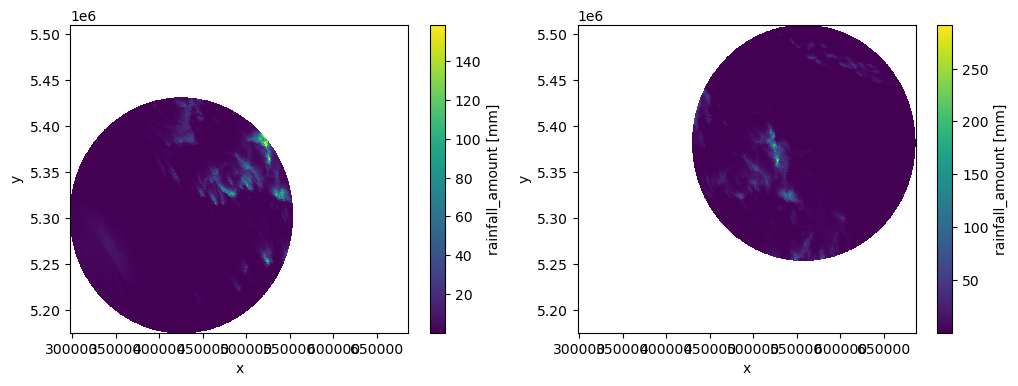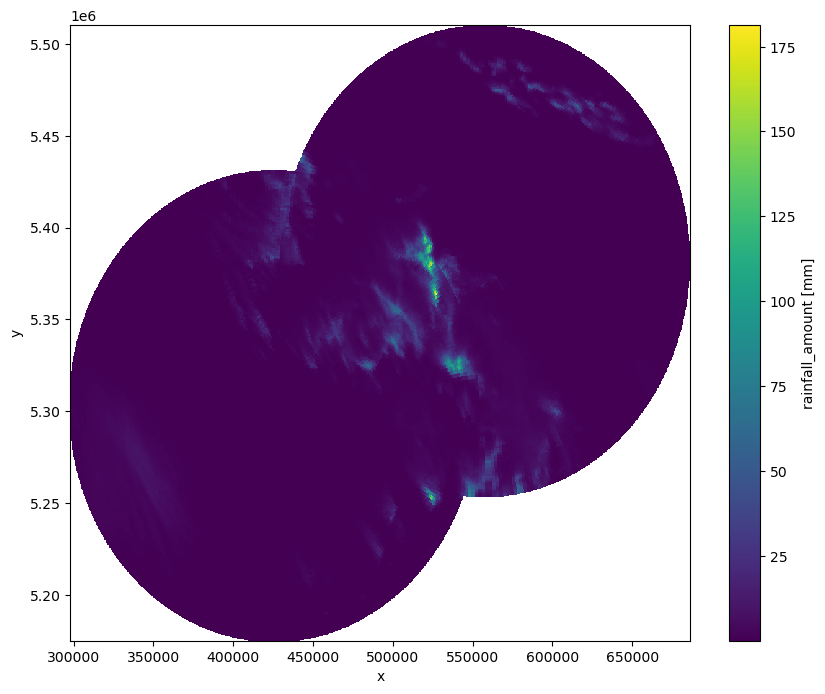Recipe #1: Clutter and attenuation correction plus composition for two DWD radars#
This recipe shows a workflow to process radar data provided by the German Weather Service (DWD). The processing includes:
(1) Reading local DX-Data for radars Feldberg and Tuerkheim.
(2) Clutter correction using the Gabella filter algorithm.
(3) Attenuation correction using the modified Kraemer algorithm.
(4) Conversion from reflectivity to rainfall using the Z-R Conversions module.
(5) Accumulation of rainfall depths over the entire event.
(6) Composition of data from both radars to a common Cartesian grid (UTM Zone 32). Composition is based on a weighted combination, using the sampling volume as a quality criterion.
(7) Plotting a rainfall map using cartesian plot.
[1]:
import wradlib as wrl
import xarray as xr
import matplotlib.pyplot as plt
import warnings
warnings.filterwarnings("ignore")
try:
get_ipython().run_line_magic("matplotlib inline")
except:
plt.ion()
import numpy as np
/home/runner/micromamba/envs/wradlib-tests/lib/python3.11/site-packages/h5py/__init__.py:36: UserWarning: h5py is running against HDF5 1.14.3 when it was built against 1.14.2, this may cause problems
_warn(("h5py is running against HDF5 {0} when it was built against {1}, "
[2]:
import glob
import os
def read_data(flist, site):
"""Helper function to read raw data for a list of datetimes <dtimes>"""
dalist = []
for f in flist:
data, attrs = wrl.io.read_dx(f)
dtime = dt.datetime.strptime(os.path.basename(f)[15:25], "%y%m%d%H%M")
dalist.append(
wrl.georef.create_xarray_dataarray(
data,
r=np.arange(500, data.shape[1] * 1000 + 500, 1000),
phi=attrs["azim"],
theta=attrs["elev"],
site=site,
sweep_mode="azimuth_surveillance",
).assign_coords(time=dtime)
)
ds = xr.concat(dalist, "time")
return ds.assign_coords(elevation=ds.elevation.median("time"))
def process_polar_level_data(radarname, site):
"""Reading and processing polar level data (DX) for radar <radarname>"""
print("Polar level processing for radar %s..." % radarname)
# preparations for loading sample data in source directory
files = glob.glob(
os.path.join(
wrl.util.get_wradlib_data_path(), f"dx/recipe1_data/raa*{radarname}*bin"
)
)
if len(files) == 0:
print(
"WARNING: No data files found - maybe you did not extract "
"the data from data/recipe1_data.zip?"
)
# loading the data (two hours of 5-minute images)
data = read_data(files, site)
# Clutter filter on an event base
clmap = wrl.classify.filter_gabella(data.mean("time"), tr1=12, n_p=6, tr2=1.1)
data_ipol = wrl.ipol.interpolate_polar(data, mask=clmap)
# correcting for attenuation
pia = data_ipol.wrl.atten.correct_attenuation_constrained(
a_max=1.67e-4,
a_min=2.33e-5,
n_a=100,
b_max=0.7,
b_min=0.65,
n_b=6,
gate_length=1.0,
constraints=[wrl.atten.constraint_dbz, wrl.atten.constraint_pia],
constraint_args=[[59.0], [10.0]],
)
data_atten = data_ipol + pia
# converting to precipitation depth
R = wrl.zr.z_to_r(wrl.trafo.idecibel(data_atten), a=256, b=1.4)
depth = wrl.trafo.r_to_depth(R, 300.0)
depth.attrs = R.attrs
# calculate hourly accumulation
accum = depth.sum("time")
accum.attrs = {
"standard_name": "rainfall_amount",
"long_name": "rainfall_amount",
"short_name": "RSUM",
"units": "mm",
}
return accum
[3]:
def bbox(*args):
"""Get bounding box from a set of radar bin coordinates"""
xy = np.array(
[
[
arg.x.min().values,
arg.x.max().values,
arg.y.min().values,
arg.y.max().values,
]
for arg in args
]
)
xmin = xy[..., 0].min()
xmax = xy[..., 1].max()
ymin = xy[..., 2].min()
ymax = xy[..., 3].max()
return xmin, xmax, ymin, ymax
[4]:
import zipfile
import shutil
import datetime as dt
# set timer
start = dt.datetime.now()
# unzip data
filename = wrl.util.get_wradlib_data_file("dx/recipe1_data.zip")
targetdir = wrl.util.get_wradlib_data_path() + "/dx/recipe1_data"
with zipfile.ZipFile(filename, "r") as z:
z.extractall(targetdir)
# set scan geometry and radar coordinates
# r = np.arange(500.0, 128500.0, 1000.0)
# az = np.arange(0, 360)
tur_sitecoords = (9.7839, 48.5861, 0)
fbg_sitecoords = (8.005, 47.8744, 0)
# processing polar level radar data
# Tuerkheim
tur_accum = process_polar_level_data("tur", site=tur_sitecoords)
# Feldberg
fbg_accum = process_polar_level_data("fbg", site=fbg_sitecoords)
Downloading file 'dx/recipe1_data.zip' from 'https://github.com/wradlib/wradlib-data/raw/pooch/data/dx/recipe1_data.zip' to '/home/runner/work/wradlib/wradlib/wradlib-data'.
Polar level processing for radar tur...
Polar level processing for radar fbg...
[5]:
# remove unzipped files
if os.path.exists(targetdir):
try:
shutil.rmtree(targetdir)
except Exception:
print("WARNING: Could not remove directory data/recipe1_data")
# derive UTM Zone 32 coordinates of range-bin centroids
# create osr projection using epsg number for UTM Zone 32
proj_utm = wrl.georef.epsg_to_osr(32632)
[6]:
tur_accum = tur_accum.wrl.georef.georeference(crs=proj_utm)
fbg_accum = fbg_accum.wrl.georef.georeference(crs=proj_utm)
[7]:
# define target grid for composition
xmin, xmax, ymin, ymax = bbox(tur_accum, fbg_accum)
x = np.linspace(xmin, xmax + 1000.0, 1000)
y = np.linspace(ymin, ymax + 1000.0, 1000)
grid_coords = wrl.util.gridaspoints(y, x)
cart = xr.Dataset(coords={"x": (["x"], x), "y": (["y"], y)})
[8]:
# quality index
tur_pv = tur_accum.wrl.qual.pulse_volume(1000.0, 1.0)
fbg_pv = fbg_accum.wrl.qual.pulse_volume(1000.0, 1.0)
[9]:
tur_gridded = tur_accum.wrl.comp.togrid(
cart,
radius=128500.0,
center=(tur_accum.y.mean(), tur_accum.x.mean()),
interpol=wrl.ipol.Nearest,
)
tur_quality_gridded = tur_pv.wrl.comp.togrid(
cart,
radius=128500.0,
center=(tur_pv.y.mean(), tur_pv.x.mean()),
interpol=wrl.ipol.Nearest,
)
fbg_gridded = fbg_accum.wrl.comp.togrid(
cart,
radius=128500.0,
center=(fbg_accum.y.mean(), fbg_accum.x.mean()),
interpol=wrl.ipol.Nearest,
)
fbg_quality_gridded = fbg_pv.wrl.comp.togrid(
cart,
radius=128500.0,
center=(fbg_pv.y.mean(), fbg_pv.x.mean()),
interpol=wrl.ipol.Nearest,
)
[10]:
fig = plt.figure(figsize=(12, 4))
ax1 = fig.add_subplot(121)
fbg_gridded.plot(ax=ax1)
ax2 = fig.add_subplot(122)
tur_gridded.plot(ax=ax2)
[10]:
<matplotlib.collections.QuadMesh at 0x7f5f7c44f250>

[11]:
# compose the both radar-data based on the quality information
# calculated above
radar = xr.DataArray(["tur", "fbg"], dims="radar")
radargrids = xr.concat([tur_gridded, fbg_gridded], dim=radar)
qualitygrids = xr.concat(
[1.0 / (tur_quality_gridded + 0.001), 1.0 / (fbg_quality_gridded + 0.001)],
dim=radar,
)
[12]:
print("Composing Tuerkheim and Feldbarg data on a common grid...")
composite = radargrids.wrl.comp.compose_weighted(qualitygrids)
print("Processing took:", dt.datetime.now() - start)
Composing Tuerkheim and Feldbarg data on a common grid...
Processing took: 0:00:08.313686
[13]:
# Plotting rainfall map
plt.figure(figsize=(10, 8))
ax = fig.add_subplot(111, aspect="equal")
composite.plot(cmap="viridis")
ax.grid()
ax.set_xlim(min(x), max(x))
ax.set_ylim(min(y), max(y))
[13]:
(5175389.476956294, 5510145.114252917)

Download required data at the wradlib-data repository.
Note
In order to run the recipe code, you need to extract the sample data into a directory pointed to by environment variable WRADLIB_DATA.
